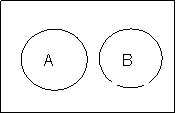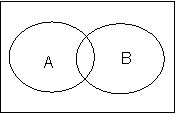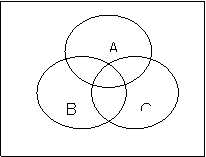SETS & Permutation and Combination
Principle of Inclusion and Exclusion
Definition: The
number of elements in a set A is denoted by ![]() . Hence if set A
contains n elements, we write
. Hence if set A
contains n elements, we write ![]() .
.
Definition: We say that 2 sets, A and B, are mutually
exclusive if ![]() .
.
Hence, given 2 mutually exclusive sets, A and B, we
have ![]()

In general, if A and B are finite sets. Then
![]()

Let A, B and C be finite sets. Then
![]()

Let A, B, C and D be finite sets. Then
![]()
Application 1.
Find the number of integers in ![]() which are divisible by
2,3 or 5.
which are divisible by
2,3 or 5.
Let A be the subset of S which contains elements that
are divisible by 2.
Let B be the subset of S which contains elements that
are divisible by 3.
Let C be the subset of S which contains elements that
are divisible by 5.
![]()
![]() is the subset of S
which contains elements that are divisible by 6
is the subset of S
which contains elements that are divisible by 6
![]() is the subset of S
which contains elements that are divisible by 15
is the subset of S
which contains elements that are divisible by 15
![]() is the subset of S
which contains elements that are divisible by 10
is the subset of S
which contains elements that are divisible by 10
![]() is the subset of S
which contains elements that are divisible by 30
is the subset of S
which contains elements that are divisible by 30
Hence ![]() .
.
![]()
Exercise 1
A. Let A,
B and C be finite sets. Prove that
(i) ![]() ;
;
(ii) ![]()
where A'
and B' are the complements of A and B respectively.
B Apply the result of A(ii) to find the
number of integers from 1 to 250, inclusive, which are not divisible by 2 nor
by 7 but are divisible by 5.
ANSWER 21
Application 2
Let S be the set of 14 students and ![]() be the properties that a students attends the course
Philosophy, Economic, Chinese respectively.
be the properties that a students attends the course
Philosophy, Economic, Chinese respectively.
|
Student |
1 |
2 |
3 |
4 |
5 |
6 |
7 |
8 |
9 |
10 |
11 |
12 |
13 |
14 |
|
|
4 |
|
|
4 |
|
|
|
4 |
4 |
|
|
4 |
|
|
|
|
4 |
4 |
4 |
4 |
|
4 |
|
4 |
|
4 |
4 |
|
4 |
|
|
|
4 |
|
4 |
|
|
|
|
4 |
4 |
|
4 |
|
|
4 |
Let w(![]() ) denote the number of elements in S satisfying
) denote the number of elements in S satisfying ![]() , i =1,2,3
, i =1,2,3
w(![]() ) means the number of elements in S satisfying both
) means the number of elements in S satisfying both ![]() , i,j=1,2,3
, i,j=1,2,3
w(![]() ) = 5 w(
) = 5 w(![]() ) = 9 w(
) = 9 w(![]() ) = 6
) = 6
w(![]() )=3 w(
)=3 w(![]() )= 3 w(
)= 3 w(![]() )= 4
)= 4
w(![]() )= 2
)= 2
The number of students who did not attend any course
=
![]() - { w(
- { w(![]() ) + w(
) + w(![]() ) + w(
) + w(![]() ) }
) }
+ {w(![]() ) + w(
) + w(![]() ) + w(
) + w(![]() ) }
) }
- {w(![]() )}
)}
= 14 - 20+
10-2 = 2
The number of students who attended exactly one
course =
{ w(![]() ) + w(
) + w(![]() ) + w(
) + w(![]() ) }
) }
-![]() {w(
{w(![]() ) + w(
) + w(![]() ) + w(
) + w(![]() )}
)}
+![]() {w(
{w(![]() ) }
) }
= 20 - 2(10) +3(2) = 6
The number of students who attended exactly two
courses =
{w(![]() ) + w(
) + w(![]() ) + w(
) + w(![]() )}
)}
- ![]() {w(
{w(![]() ) }
) }
= 10 - 3(2) =4
The number of students who attended exactly three courses=
Exercise 2
Find the number of integers from 1 to 100 inclusive,
which are divisible by
(a)
non of 2, 3, 5?
(b)
exactly one of 2,3, 5?
(c)
exactly two of 2,3,5?
(d)
all of 2,3,5?
ANSWER 26,48,23,3
Let S ={ 1,2,3,….100} and![]() be the properties that the number is divisible by 2, 3 and 5
respectively.
be the properties that the number is divisible by 2, 3 and 5
respectively.
Application 3
Find the number of arrangement using all letters of
the word MEGAPHONES which contain no pattern of MA, POH and SHEE.
Let S be the set of all arrangement of the given
letters. Let ![]() be the properties that the arrangement contains the pattern
MA, POH, SHEE respectively.
be the properties that the arrangement contains the pattern
MA, POH, SHEE respectively.
Let w(![]() ) be the number of elements in S satisfying
) be the number of elements in S satisfying ![]() , i=1,2,3. That
is w(
, i=1,2,3. That
is w(![]() ) means the number of arrangement which contains the pattern
MA.
) means the number of arrangement which contains the pattern
MA.
w(![]() ) means the number of elements in S satisfying
) means the number of elements in S satisfying ![]() , i,j=1,2,3.
That is w(
, i,j=1,2,3.
That is w(![]() ) means the number of arrangement which contains both MA and
POH.
) means the number of arrangement which contains both MA and
POH.
![]() =
=![]() = 1 814 400
= 1 814 400
w(![]() )+ w(
)+ w(![]() ) + w(
) + w(![]() ) =
) =![]() =206 640
=206 640
w(![]() )+w(
)+w(![]() )+w(
)+w(![]() )=
)=![]() +0= 3240
+0= 3240
w(![]() )= 0
)= 0
Hence the number arrangement using all letters of the
word MEGAPHONES which contain no pattern of MA, POH and SHEE =
![]() - { w(
- { w(![]() )+ w(
)+ w(![]() ) + w(
) + w(![]() ) } + {w(
) } + {w(![]() )+w(
)+w(![]() )+w(
)+w(![]() ) } - w(
) } - w(![]() )
)
=161 100
Exercise 3
Find the number of arrangements using all the letters
of the word COMBINATIONS which do not contain any of the pattern BIN, SIN and
TOMB.
ANSWER 56185800
Application 4
Find
the number of integer solutions for the equation ![]() with
with ![]() .
.
(Remark: The answer to this question is trivial
intuitively since 5+6+7=18 and ![]() , we can make use of set theory to outline a proof which is
applicable for
, we can make use of set theory to outline a proof which is
applicable for ![]() with
with ![]() where
where ![]() .)
.)
Let
S be the set of all integer solutions for ![]() with
with ![]() .
.
Let
![]() be the properties that
be the properties that
![]() respectively.
respectively.
Let w(![]() ) be the number of elements in S satisfying
) be the number of elements in S satisfying ![]() .
.
It can be shown that ![]() =
= ![]() =
=![]()
w(![]() ) + w(
) + w(![]() ) + w(
) + w(![]() ) =
) =![]() =
=![]()
w(![]() )+w(
)+w(![]() ) + w(
) + w(![]() )=
)=![]() =
=![]()
w(![]() ) =
) = ![]() =
=![]()
The number of integer solutions for the equation ![]() with
with ![]() is
is
![]() - { w(
- { w(![]() ) + w(
) + w(![]() ) + w(
) + w(![]() ) } + { w(
) } + { w(![]() )+w(
)+w(![]() ) + w(
) + w(![]() )} - w(
)} - w(![]() ) =
) = ![]() - {
- { ![]() } +{
} +{ ![]() } -
} - ![]() = 0
= 0
Exercise 4
Find the number of integer solutions for the equation
![]() with
with ![]() .
.
ANSWER 106
Prepared By Ms Khong Beng Choo
Adapted from MQ3207 Combinatorial Analysis,2001